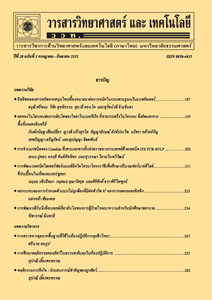ผลของวิธีการที่แตกต่างต่อการชะลอการเกิดสีน้ำตาลของแก่นตะวันสดตัดแต่งพร้อมบริโภค
Main Article Content
Abstract
Tuber of Jerusalem artichokes are an excellent source of nutrition and herbal properties. The purpose of this research was to investigate the effects of different methods on delayed browning of ready-to-eat fresh pre-cut Jerusalem artichokes. Various methods were used, including blanching in boiling water, immersing in honey solution, immersing in a salt solution, immersing in citric acid solution, and immersing in sodium metabisulfite solution were compared with the control. In this study, weight loss, color changing, hardness and sensory evaluation of fresh-cut Jerusalem artichokes were investigated by using a completely randomized design. The results showed that the suitable method was immersing in sodium metabisulfite solution (0.1 g per kg of water). Apparently, it had the lowest browning value and lowest weight loss. Moreover, the hardness was close to the fresh Jerusalem artichoke. In terms of sensory acceptability, it had the highest mean scores on appearance, texture, flavor, and overall liking at moderate level. Therefore, fresh Jerusalem artichokes those are transformed to ready-to-eat fresh pre-cut items, will help to promote more widespread consumption. Furthermore, it also responds to the lifestyle of modern health conscious consumers as well.
Article Details
References
[2] Tudpor, S. and Singthong, J., 2017, Bioactive compound and antioxidant activity of sunchoke (Helianthus tuberosus L.) at different harvest times, J. Sci. Tech., Ubonratchathani Univ. 19: 45-57. (in Thai)
[3] Kaewwongsa, W., Puewdum, M. and Pensu, V., 2013, Effect of Jerusalem artichoke powder in diets on egg production performance in laying hens, Agric. Sci. J. (Suppl.): 271-274. (in Thai)
[4] Thai Agricultural Standard, Good Manufacturing Practices for Ready-to-Eat Fresh Pre-Cut Fruits and Vegetables, Available Source: https://www.acfs.go.th/standard/download/GMP-CUT-FRUITS-AND-VEGETABLES.pdf, August 25, 2018. (in Thai)
[5] Rattanapanone, N., 2014, Food chemistry, Bangkok, Odeon store, 504 p. (in Thai)
[6] Bhoyen, K. and Suwonsichon, S., 2013, Effects of blanching and acid treatments on chemical and physical properties of Jerusalem artichoke powder, pp. 178-185, 51th Kasetsart University Annual Conference: Agricultural Extension and Home Economics, Agro-Industry, Bangkok. (in Thai)
[7] Lertwiram, P. and Sawatming, P., Use of Rice Bran Extracts, Chemical Method and Thermal Process to Delay Browning in Mashed Potato, Available Source: https://www.agro.cmu.ac.th/agro60/school/fst/601499/research_exercise_journal/file_upload/551310036.pdf, August 25, 2018. (in Thai)
[8] Duncan, D.B., 1995, Multiple range and multiple F tests, Biometrics 11: 1-42.
[9] Yuenyongputtakal, W., 2013, Factors influencing on dewatering by osmotic dehydration of fruits and vegetables, Burapha Sci. 18(1): 226-233. (in Thai)
[10] Bach, V., Jensen, S., Clausen, M.R., Bertram, H.C. and Edelenbos, M., 2013, Enzymatic browning and after-cooking darkening of Jerusalem artichoke tubers (Helianthus tuberosus L.), Food Chem. 141: 1445-1450.
[11] Kaszas, L., Kovacs, Z., Nagy, E., Elhawat, N., Abdalla, N. and Domokos-Szabolcsy, E., 2018, Jerusalem artichoke (Helianthus Tuberosus L.) as a potential chlorophyll source for humans and animals nutrition, Env. Biodiv. Soil Security 2: 1-9.
[12] Tanjor, S., Judprasong, K., Chaito, C. and Jogloy, S. 2012, Inulin and fructooligosacharides in different varieties of Jerusalem artichoke (Helianthus tuberosus L.), KKU Res. J. 17(1): 25-34. (in Thai)
[13] Lee, Y.J., Lee, O. and Yoon, W.B., 2017, Effect of inulin in Jerusalem artichoke (Helianthus tuberosus L.) flour on the viscoelatic behavior of cookie dough and quality of cookies, pp. 35-44, Proceedings of the International Food Operations and Processing Simulation Workshop.
[14] Sila, D.N., Smout, C., Vu, S.T., Loey, A.V. and Hendrickx, M., 2005, Influence of pretreatment conditions on the texture and cell wall components of carrots during thermal processing, J. Food Sci. 70: E85-E91.
[15] Suphamityotin, P., 2013, Fruit and Vegetable Technology, Odeon Store, Bangkok, 280 p. (in Thai)
[16] Israili, Z.H., 2014, Antimicrobial properties of honey, Am. J. Ther. 21: 304-323.


